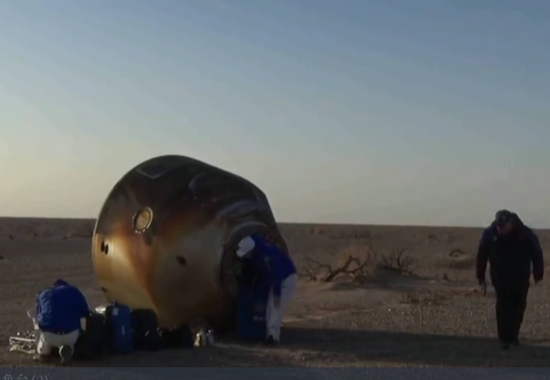China's space exploration has been helping unlock a deeper understanding of the universe, from Earth to the moon; from Mars to the infinite universe.
FROM EARTH TO MOON
With multiple satellites launched, China has largely completed its High-resolution Earth Observation System, providing land observation services. The country can also view waters around the globe on all scales and observe the global atmosphere to boost disaster response capability.
China's success of the Chang'e-5 mission marked the conclusion of a three-step lunar exploration program that consisted of orbiting, landing on the moon, and returning with samples.
The Chang'e-5 mission was China's most complicated systemic space project that required the most diversified technologies. On Dec. 17, 2020, the return capsule of the Chang'e-5 probe brought back the country's first samples from an extraterrestrial body.
Last July, the China National Space Administration released the online database of the second batch of lunar samples brought back by the Chang'e-5 probe. Researchers and the public can access the Lunar and Deep Space Exploration Scientific Data and Sample Release System via the website www.clep.org.cn, where they can apply for data and samples. The first batch of the lunar samples, about 17 grams, was delivered to 13 institutions in the same month.
The analysis of the data sent back by Chang'e-5 lander is also yielding results. A study published last month showed that the moon had turned drier within a certain period, probably due to its mantle reservoir's degassing. The findings provide more clues for future lunar missions as crewed lunar stations are in the pipeline in the following decades.
FROM MARS TO INFINITY
Last May, China landed its Mars probe, Tianwen-1, on the red planet, ushering in a new chapter of China's deep space exploration and marking another contribution to humanity's exploration of the universe.
The Mars rover Zhurong has traveled more than 1,200 meters on the planet and is currently heading toward a region that might have been the coastline of an ancient ocean, looking for clues about Mars' evolution.
China's first solar exploration satellite, launched into space last October, is sending data on solar flares back to Earth. It can deepen our understanding of the sun.
Shrinivas R. (Shri) Kulkarni, George Ellery Hale Professor of Astronomy and Planetary Science at California Institute of Technology, told Xinhua in an interview last year that the universe is much stranger than people think. However, building astronomy telescopes is very expensive and no country can do astronomy all by itself.
He noted that China's telescopes like FAST and HXMT had become driving engines for discoveries.
Last March, China announced that its Five-hundred-meter Aperture Spherical Radio Telescope, or FAST, could be accessed by astronomers worldwide.
Located in a naturally deep and round karst depression in southwest China's Guizhou Province, FAST started formal operation in January 2020. It is the world's most sensitive radio telescope. With FAST, scientists have identified over 500 new pulsars.
In 2017, China launched a space telescope, the Hard X-ray Modulation Telescope (HXMT), or Insight, to observe black holes, neutron stars, gamma-ray bursts, and other celestial phenomena.
In 2020, scientists, using HXMT, discovered the strongest magnetic field ever observed in the universe, on the surface of a neutron star named GRO J1008-57.
Last year, an international team of researchers reported that a fast radio burst detected by HXMT came from a magnetar in the Milky Way, marking a milestone in understanding the nature of the mysterious signal emanating from the universe.
In 2015, China launched its first dark matter probe satellite Wukong. It has finished the full-sky scan 11 times and collected about 10.7 billion cases of high-energy cosmic rays, obtaining the most accurate measurement results of cosmic-ray electrons, protons, and helium nuclei above the trillion electron volts energy region.
In 2021, China started to build its space station, opening a new foothold for humanity in space. This year, multiple missions have been planned to complete the construction, including launching two lab modules.
China's space station, guided by the idea of building a community with a shared future for humanity, will become a common home transcending Earthly bonds and an outpost for countries worldwide to explore the universe through cooperation.

Brazil includes Chinese Mid-Autumn Festival in its official events calendar
(ECNS) -- The Sao Paulo City Council on Monday local time enacted Law No. 18342, including the Chinese Mi...(4489)人阅读时间:2025-12-05
LABUBU joins New York's Thanksgiving Parade
(ECNS) — The 99th Macy’s Thanksgiving Day Parade was held in Manhattan, New York, Wednesday, ...(4833)人阅读时间:2025-11-30
'Phone Tap' tax refunds boost China shopping appeal
(ECNS) — China’s inbound tourism is rising as visa-free policies expand and measures to facilitate...(4664)人阅读时间:2025-11-24
Senior Japanese official leaves China's Foreign Ministry without any response to media
(ECNS) -- A senior Japanese foreign ministry official left China's Ministry of Foreign Affairs in Beijing ...(5314)人阅读时间:2025-11-19
China's Shenzhou-20 crew returns to Earth
(ECNS) -- The return capsule of the Shenzhou-21 spaceship, carrying the Shenzhou-20 crew, landed safely at the...(5659)人阅读时间:2025-11-15
Brazil includes Chinese Mid-Autumn Festival in its official events calendar

LABUBU joins New York's Thanksgiving Parade

'Phone Tap' tax refunds boost China shopping appeal

Senior Japanese official leaves China's Foreign Ministry without any response to media

China's Shenzhou-20 crew returns to Earth

China Eastern resumes Shanghai–Delhi passenger flights

World's first industrial 5G standard led by China, Germany published

China's Shenzhou XXI crewed spaceship docks with space station combination

Brazil includes Chinese Mid-Autumn Festival in its official events calendar

LABUBU joins New York's Thanksgiving Parade

'Phone Tap' tax refunds boost China shopping appeal

Senior Japanese official leaves China's Foreign Ministry without any response to media

China's Shenzhou-20 crew returns to Earth

China Eastern resumes Shanghai–Delhi passenger flights

World's first industrial 5G standard led by China, Germany published

China's Shenzhou XXI crewed spaceship docks with space station combination